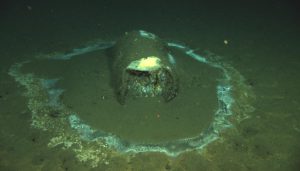MAY 3, 2021

A sprawling dumpsite off the Los Angeles coast, littered with barrels of waste, had been mostly hidden from the public eye for over half a century. Now, marine scientists revealed the field of submerged waste, some of it likely toxic.
They detected around 27,000 barrels.
Over two weeks in March, scientists with NOAA and the Scripps Institution of Oceanography dropped two autonomous underwater vehicles (they look like small submarines) into the ocean, approximately 12 miles off the coast. The researchers knew barrels holding waste laden with toxic chemicals like DDT were down there: Limited, though telltale footage and past records hinted at the magnitude of last century’s massive dumping campaign. But the robots, using sonar technology to scour 36,000 acres of the seafloor, proved it.
“It was staggering to us,” Eric Terrill, chief scientist of the expedition and an oceanographer at Scripps Institution of Oceanography, told Mashable.
Some records suggested hundreds of thousands of barrels had been dumped off the Los Angeles coast between 1947 and 1961. The researchers suspected they might find a plethora of waste. “But to visibly see it in the data was pretty humbling,” Terrill said.
“It was staggering to us”
Scripps announced the expedition’s results earlier this week. The discovery opens a floodgate of environmental and biological questions for local, state, and federal agencies. How is this impacting marine wildlife? How contaminated is the seabed? “There are implications across the entire food web, all the way to humans, that we don’t understand just yet,” explained Terrill.
“Are those chemicals moving into the food web or are they staying somewhat in place? We don’t really know,” agreed Katherine Pease, a biologist and the science and policy director at Heal the Bay, an environmental advocacy group in LA.
It’s unknown if the waste, some at depths of 3,000 feet underwater, can be cleaned up, or should be. An endeavor that might disturb contaminated soil could spread toxins, making matters worse. “It is a huge, overwhelming problem to think about,” said Pease. “Are there options for cleaning it up? Or is it better to leave [the barrels]?” These questions will take years to answer.
Another question is who’s responsible for the dumping? One infamous company, the now-folded Montrose Chemical Corporation, is already known to have been a serial dumper, because dumping was permitted in the mid-20th century (before the EPA existed and the agency instituted the Ocean Dumping Act), though other companies may have dumped too. Montrose — once a major supplier of the since-banned insecticide DDT — is already culpable for discharging bounties of toxic waste into L.A. County storm drains and sewer systems, resulting in massive DDT contamination off the coast (specifically the Palos Verdes Shelf). But the chemical company is also known to have dumped many DDT-contaminated waste drums in the region, according to NOAA.
Locating the drums was made possible by sonar technology. In a basic sense, the underwater robots beamed sound pulses to the seafloor, and the sounds reflected back. This reveals the shape, size, and other clues about the objects down there. The vehicles swept the seafloor with broad pulses (shown in the graphic above) like a wide push broom, explained Scripps’ Terrill, allowing the team to cover a large swathe of area. They determined “with high confidence” that some 27,000 objects are barrels.
On the seafloor, researchers found telltale signs of organized, large-scale dumping. “There are several distinct track-line patterns in the surveyed area, suggesting that the dumping was repeatedly done from an underway platform such as a moving ship or barge,” Terrill said in a statement, noting some of the lines are 11 miles long.
While the expedition didn’t reveal what’s inside each barrel, many likely contain waste laden with DDT. It’s a long-lived chemical that accumulates in fatty animal tissues, like those in fish and marine mammals. DDT is linked to cancer, for example, in sea lions. The EPA calls DDT a “probable human carcinogen,” and recent research linked health risks in granddaughters whose grandmothers were exposed to DDT decades ago. In L.A., Heal the Bay actively educates the local community and anglers about consuming certain fish known to be contaminated with DDT. Warnings are posted on local piers, too.
While finding some 27,000 barrels of waste is certainly stunning, it doesn’t mean the beaches are suddenly dangerous — though eating contaminated fish is potentially harmful. “[The detection of barrels] is alarming, but not an immediate cause for not going in the water,” said Pease.
It’s not just barrels discarded on the seafloor, however. The robots identified around 73,000 other objects. For now, it’s unknown what they are.
“There’s a whole lot of other stuff on the sea bed that is unfinished business,” said Terrill.
Courtesy/Source: Mashable









































































































